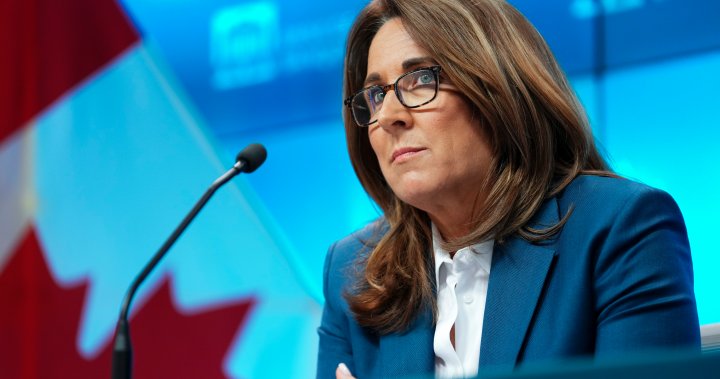Strong housing market rebound could slow pace of rate cuts: BoC – National

A stronger-than-expected rebound in the Canadian economy, particularly from the housing market, could push the Bank of Canada to press pause on its rate cut cycle, according to new deliberations.
And at least one central bank official is holding off on declaring victory over inflation, despite a return to the two per cent target.
The central bank on Wednesday published the meeting minutes that led the governing council to cut its benchmark interest rate by another 25 basis points earlier this month. The third consecutive cut brought the Bank of Canada’s policy rate to 4.25 per cent.
The deliberations did not show any hints that monetary policymakers weighed a steeper cut of half a percentage point.
The governing council did discuss different scenarios for the future path for interest rates, however.
If signs of weakness in the labour market and wider economy worsen in the months ahead, “it may be appropriate to lower the policy interest rate more quickly,” the deliberations read.
But in an upside scenario, the Bank of Canada’s rate cuts to date could spur a faster rebound in the remainder of this year and into 2025.
“The housing market could strengthen quickly, boosting house prices and shelter price inflation,” the deliberations read. The governing council also cited risks that persistent wage growth fuels inflation in services as productivity wanes.

“In this scenario, it may be appropriate to slow the pace of further cuts in the policy rate,” the deliberations read.

Get weekly money news
Get expert insights, Q&A on markets, housing, inflation, and personal finance information delivered to you every Saturday.
Canada’s housing market has been in a “holding pattern” over the summer despite the start of rate cuts, the Canadian Real Estate Association said earlier this week. With expectations for further interest rate cuts to come and no sign yet of prices reaccelerating, CREA suggested that buyers may be content waiting on the sidelines for lower borrowing costs.
Market watchers who spoke to Global News earlier this month expect home sales to pick up in the fourth quarter of the year, but not return to pre-pandemic levels amid still-high borrowing costs and prices.
The governing council indicated that, overall, inflation had eased “as expected,” with risks increasingly weighted towards economic growth ending up weaker than originally forecast in the second half of the year.
“They agreed that if inflation continued to ease as expected, that it was reasonable to expect that the policy rate would decline further,” the deliberations read. The council added there is no “predetermined path” for interest rates.
Inflation back at target, but the job’s not done: Rogers
Meanwhile, news this week that inflation had returned to the central bank’s two per cent target in August doesn’t mean the central bank’s efforts are done, according to a senior official.
Annual inflation cooled sharply to two per cent last month, Statistics Canada reported Tuesday, hitting the Bank of Canada’s target after months of raising interest rates to tame rampant price pressures.
Carolyn Rogers, senior deputy governor at the central bank, spoke at a Bloomberg event on Tuesday, where she was asked whether two per cent inflation meant it was “mission accomplished” for the Bank of Canada after the most rapid tightening cycle in its history.
“It was good news. It was good news for the bank, more importantly it was good news for Canadians. It’s been a long journey, it’s been a tough journey,” Rogers said.
“We’re glad to see two per cent, but no, there’s still work to do.”

The Bank of Canada needs to see that the return to two per cent inflation is “sustainable,” and not a one-time event, Rogers explained.
The central bank is still looking for trends in its preferred measures of core inflation to show that price pressures will hold at two per cent for the long term, she said.
Rogers noted that the Bank of Canada is expecting some “bumpiness” in the headline inflation figure in the months ahead, but suggested that, depending on the factors, that might be something the central bank is willing to look through.
There’s also the matter of the so-called “soft landing,” which will answer whether the Bank of Canada was able to effectively restore price stability without tipping the economy into a recession.
So far, Canada has avoided that fate, but unemployment has been rising and some economists expect that third-quarter economic results will undershoot the central bank’s latest estimates.
“We’ve got to stick the landing,” Rogers said.
The Bank of Canada will get another set of inflation data, as well as updates on the labour force and economic activity, before its next decision set for Oct. 23.

© 2024 Global News, a division of Corus Entertainment Inc.








